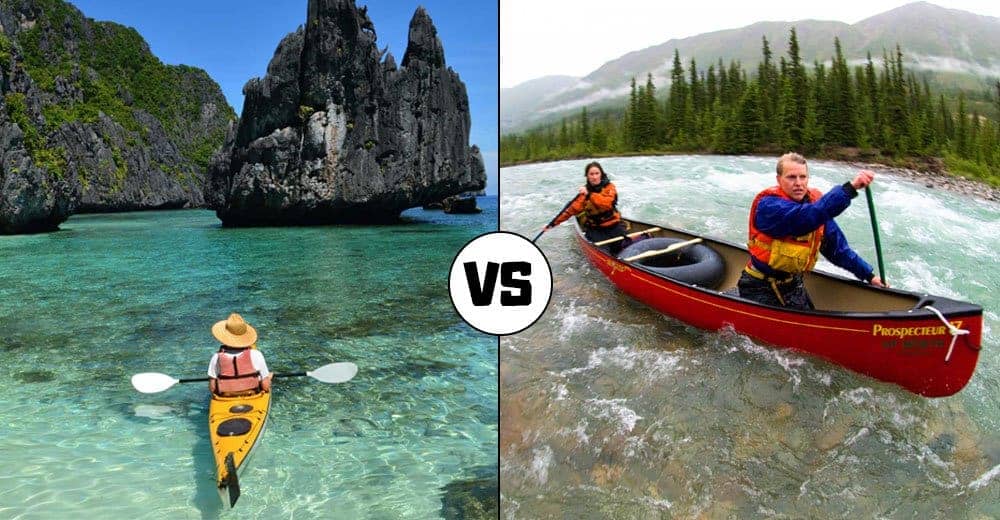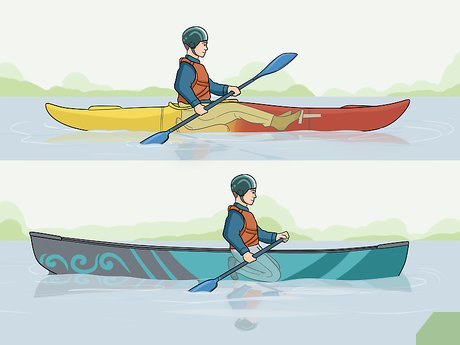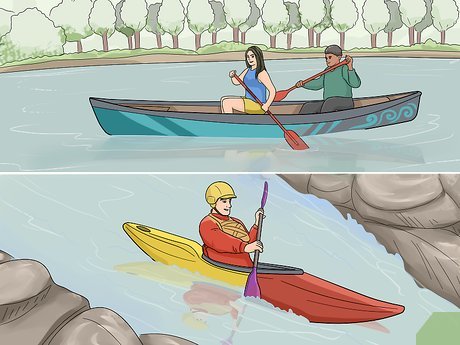
Canoe vs Kayak: Even in case you know they describe two unique forms of paddle craft, you might wonder if or not a kayak or a kayak is more
stable or it is ideal for the type of paddling you need to do.
The main differences between Canoe and Kayak include different kinds of paddles used, in which the paddlers are situated, and how
much equipment a kayak vs a kayak may hold. Additionally, there are versions in the
hull layouts of each and every one. Canoes are usually wider, longer and heavier,
while kayaks are smaller, thinner and built for speed.
Other than the different paddles, chair positions, and shapes which define canoes vs kayaks, there are also differences in the way they’re used
and other info which could help you decide which, canoe or
kayak, are the best fit for you and just how and where you’d like to
paddle.
Canoe or Kayak – Which Should You Choose?
Before purchasing a kayak or kayak, here are a Couple of questions to keep in mind:
- Is comfort an important element?
- Is the rate or managing more significant?
- Are you really okay with getting a bit wet?
- Is stability or maneuvering more significant?
- Does your family like personal gear or do they prefer to share?
Both kayaks and canoes have several different styles, designs and availability which will influence which one you purchase.
Check out some shared Kinds of kayaks and canoes recorded below:
| Sort of Kayaks vs Canoes | Pros | Cons |
| Sit-Inside Kayaks | — Maintain you drier — Protect your body from the weather — Relatively Stable — Extra pockets |
— You may feel confined — More Challenging to get in and outside — Sit lower in the water |
| Sit-on-Top Kayaks | — Stable — Beginner-friendly — Easy to get in and out of |
-You will get moist -Easier to fall off |
| Inflatable Kayaks | — Small storage area — Don’t need cargo rack — Secure — Seats are flexible |
— Lighter — Slower in water — Make the time to inflate |
| Folding Kayaks | — Compact storage — Lightweight |
— Not as durable — Shorter lifespan — Less storage |
| Whitewater Kayaks | — Loaded — Resistant to harm — Easy to navigate |
— Unstable — Slower in open water — Not constructed for comfort |
| Recreational Canoes | — Able to carry — Stable — Easy to restrain — Can hold more people |
— More effort to paddle — Less maneuverable |
| Square Stern Canoes | — May Add a motor — Lighter |
— Harder to maneuver — Less secure |
| Racing Canoes | — glistening design — Quicker than other canoes — Stable |
— Prone to getting wet — Do not fit as many people — Specialized design |
| Whitewater Canoes | — Lighter than other canoes — Sturdy design |
— Less secure — Shorter — Do not fit as a Lot of People |
| Tandem Canoes | — Made for Several individuals — Comfortable seating — May keep you dryer — Very stable — Great for longer trips — Broad hulls |
— Hard to paddle — Not easy to move — Heavier to haul |
The Differences Between Canoes and Kayaks
That is a fantastic thing as it can help you figure out which one you prefer
and which one’s better for how you want to use it.
Let us look at some more features of canoes vs kayaks…
If you anticipate taking multi-day trips, or paddle camping
expeditions, canoes provide more space to put camping gear, coolers, and
other essential equipment. The one drawback would be that your freight has
the opportunity to get as wet as possible, so you’re going to want good dry bags
for all your gear.
Canoe vs Kayak Storage Space:
- When compared with the wide-open hull design of canoes, kayaks have a smaller and more separated storage system,
depending on the sort of kayak you decide on. - Most kayaks have watertight cargo holds. But, unlike a canoe, these cargo holds often be smaller
and therefore are made to hold electronics, little camping gear, or small coolers.
Canoe vs Kayak Stability:
- With their thicker, wider, and more layout, canoes are often more stable than your average kayak. They’re also constructed with wider and deeper hulls. But this is by design because they are meant to carry large loads of gear and people over long distances. However, canoes can be more difficult to maneuver than kayaks because of their larger average size and broader hull design.
- That being said, kayak stability
is a lot better now than a couple of short years back. And using their own smaller and lighter design, kayaks tend to glide through the water better and they are easier to move. But if you shift your own body weight in
the kayak when attempting to paddle, you might not track in a direct line. Do not worry, this is by design as it’s meant to assist you to steer more aggressively. It doesn’t feel natural at first, but you’ll get the hang of it quickly.
Staying Dry in a Canoe vs a Kayak:
How wet you get in a canoe vs a kayak is dependent upon which kind of kayak or canoe you opt to purchase.
- Ordinarily, canoes are larger and don’t ask that you lift the
paddle from side to side, and that means you are going to get less moisture when paddling them.
Also, you sit above the waterline in a kayak, from splashing
water. - As you can remain dry at a sit-inside kayak,
you can still get wet whilst paddling. Since you must tip the paddle back
and forth when you paddle from side to side, water will want to
trickle down the paddle shaft toward your hands. Luckily most kayak
paddles have little cups around the shaft on the two ends to prevent that
water from sliding down the shaft and your sleeve up.
Canoe vs Kayak Paddling:
Here’s an informative article on the different parts of a kayak paddle to give you some context.
- Canoes are intended to track water and travel directly ahead. With shorter paddles that have a single blade on one end, canoes are
greatest paddled by more than 1 individual. 1 individual can paddle a canoe, but so as to paddle straight they’ll either need to continually change which side of the canoe they paddle on or learn a special canoe stroke to remain to paddle on one side. (J-stroke)
- nearly all kayaks are made so that one individual can paddle and maneuver them with as little effort as possible. Kayak paddles have just two paddle blades (one blade on each end of the paddle). And kayak paddles are more vs shorter kayak paddles. This kayak paddle
layout allows for a single person to stroke water on each side of the kayak.
Canoe vs Kayak Seats/Comfort:
- The drawback is that canoe seats are simpler and more basic vs many kayak seats. Kayak chairs tend to get a little additional support and frequently lower back support constructed in.
- On the upside, you can get out of a canoe more quickly vs having to do a lot of shifting around plus also a little wiggling to get out of a sit-inside kayak.
- But if you enjoy feeling securely inside your boat, then sit-inside kayaks would be the thing to do. Kayaks cover your body and give you more protection against the water vs canoes where you sit in the open and much more vulnerable to the
components.
Canoe vs Kayak Design Differences:
- Bear in mind, you can still become wet, based on the way you paddle. Canoes are created with broad, open frames and inner hulls that make them larger and thicker than kayaks.
- Canoes are designed to take more people and supplies than kayaks are.
- Kayaks have a couple more design variants because they have both open and closed designs. Moreover, kayaks are often smaller and lighter than canoes.
- Since they are normally smaller, it may be more challenging to slip into a kayak, whereas you can step into many canoes pretty
easily.
Canoe vs Kayak – Fishing
Both canoes and kayaks can be used for fishing, but there are slight variations in the way you fish out of a kayak versus a kayak.
Tours & Things to do hand-picked by our insiders
They’re designed to hold more people and gear and their hulls
are intended to ride and track better in water. Place a trolling motor on a canoe and it’s fantastic for fishing. They sit in
the water, which allows you to stand or sit without flipping over. With
this design, fishing kayaks may also handle rough water better than many
fishing canoes. In addition, you have less space
to store equipment in a kayak versus a canoe. And lastly, most fishing
kayaks are designed to accommodate solo cyclists.
So,
Choosing a fishing kayak vs a fishing kayak will probably depend on how
many people are fishing with you and how much equipment you intend to
bring. For one person and a mild quantity of gear, a kayak may be the
best way to go. But if you plan to fish for longer periods of time with more
than 1 person a kayak is probably the better choice. If you want to
fish with a buddy, get a canoe or they will need another kayak.
Canoe vs Kayak – Stability
There are a Couple of Distinct features that determine how secure a kayak is Vs canoe equilibrium: how easy it’s to flip over, how it feels while on calm water, and just how stable it is if you lean towards the sides.
The stability of a water vessel is usually divided into two different categories: its own main stability, how well it will when you’re upright on calm water, and its own secondary equilibrium, how much you can lean toward the side before switching over.
But which is more stable, a canoe or a kayak?
- Canoes: In the beginning, most individuals are more
worried about primary equilibrium and rarely take into consideration the secondary
stability of a canoe or kayak.
Though secondary equilibrium is essential, canoes are utilized to relax and enjoy the surroundings (the majority of the time).
Whilst Taking a Look at the plethora of canoe Choices, you may have noticed that there were several different hull designs:
- Flat Bottom — Very stable, good tracking, maneuverability is more difficult, demands more paddle attempt
- Semi-Rounded Bottom — Decent maneuverability, tracking, less much effort to throw, and great equilibrium
- V-Bottom — Made for monitoring, very stable, easier to maneuver than the horizontal underside
- Rounded Bottom — Amazing secondary stability, greatest maneuverability
- Kayak: In kayaks, secondary stability will be more important than primary when it comes to tackling rough water. If you plan on travelling through serene rivers, then it can be better to purchase a kayak with greater primary
stability.
Different hull designs offer different stability and support:
- Rounded Bottoms — Have better secondary stability, you can lean further to the side in them, and they are quicker
- Flat Bottoms
— Best for recreational use, are inclined to have good main stability, and
they ride on top of the water rather than cutting through the water - Pontoons
— This includes most sit-on-top kayaks. They’re more stable than they
appear, great for beginners, primary stability is far better than secondary
firmness - V-Bottoms — Secondary stability will be
greater than primary stability, most classic kayaks use a combo of
the v-bottom with the rounded hull. V-bottom kayaks are extremely maneuverable.
Canoe vs Kayak – Speed
Whether it’s taking your family to the lake or you want to compete
Contrary to other kayakers or canoeists in competition, canoe versus kayak rate may be a determining factor where paddle craft you buy. Most
frequently, kayaks have greater rate characteristics because of their
lightweight, low profile, and slick design, but do they really go
faster?
Because canoes are often heavier than kayaks, it requires more energy to get them up to the very same speeds.
Normally, canoes travelling around 3mph or 4-5 km per hour.
Sustaining this speed in a kayak is harder than in a kayak.
Though your normal canoe may only travel around 3-4 mph, Eirik Veras Larsen holds the record for travel 5,000 meters (3.1 miles) in a little over 18 minutes.
It’s okay if you’re not making 5,000 meters at Olympic occasions, the
regular canoer is probably not trying to hurry somewhere; they’re there
to enjoy the ride.
Since canoeing demands more paddle attempt, speed is Harder
To achieve and maintain since it is going to need more endurance and
strength, attempting to have your canoe to go faster.
How quickly are kayaks? Depending on how much experience you have kayaking, you could be able to typical speeds around 6 km per hour (3.7 mph).
This speed also depends on paddle technique, wind speed and direction,
load capacity, endurance, and water conditions. While you can go
slower or faster, training, better paddling technique, and building up
your endurance will help you achieve higher rates in a kayak vs a
canoe.
As far as record-breaking kayaking rates move, Guinness World Records noted that Peter Bray holds the fastest crossing of the North Atlantic in a sea kayak.
He travelled from Newfoundland, Canada, to Belderrig, Ireland, for a
total of 76 days. Most of us will not even try that, but imagine
the endurance is required to keep on paddling for 76 times straight!
Canoe vs Kayak for Beginners – Which is Easier?
Bear in mind, when deciding whether you would like a canoe or a kayak, there is a certain learning curve required for everyone.
While it will be easier for beginners to venture out on a canoe, put a
Many times, beginners
struggle with pulling and pushing the water in the perfect direction and
end up turning their canoe in circles.
A large step which helps with all paddle craft is mastering good paddling technique.
Since canoes and kayaks require various paddles, the methods to
paddle them predict for slight modifications based on the sort of
paddle you utilize. When you look closely at the paddle, you’ll see that the blades are slightly
concave (similar to the shape of a spoon). With the paddle held
horizontally in front of your body, the concave side should be facing
you. Following that, you rotate your arms, then submerging a blade on one side of
the paddle initially then pull back in a sweeping movement, maintaining the
blade completely underwater until it is slightly behind you. Repeat this on the
opposite side.
- Canoe Paddling: Canoes
have only bladed paddles. To paddle, a kayak, place your hands on top of
the handle where there’s usually a little knob to grip (not the blade
finish ). Then, very similar to a kayak, then submerge the blade
into the water and scatter the water back toward you.
Now That you understand the basics of suitable paddle technique, which one is easier
to find out? Kayaks are a favourite for many novices because
they are simple to maneuver, and recreational kayaks are pretty stable.
That being said, canoes are the way to go If You Would like to Get Started
Paddling with family or friends. They are easier to master, more stable,
and more pliable for new paddlers.
Before heading out on a kayak for the first time, here are some other useful tips for a beginner:
- Do not dress for the weather dress to the water.
- Sit-on-top kayaks are beginner-friendly and do not need advanced skills like sit-inside kayaks.
- Make
sure you are seated properly on your kayak. You want a
complete selection of movement without adjusting your weight. This will help
reduce rolling and flipping. - Make certain to use proper paddling methods.
- Have spare clothing for after your kayak adventure.
- As a beginner, it is always best to kayak along with others. By doing so, you remain safe if anything happens.
The Beginner friendliness of a canoe depends upon the sort of canoe you are using. For example, fishing canoes are often less stable and may reverse easier than recreational canoes. Consequently, if you decide to begin with a
kayak, make certain you lease or purchase a good recreational kayak to
start with.
Here are some additional tips for canoe beginners:
- Ensure that you and your spouse paddle on opposite sides of the ship. This will keep you from moving in circles.
- Locate the rhythm with your partner. This is important when monitoring and
sweeping water since if you paddle inconsistently with your partner,
there might be issues with direction and movement. - Keep your paddle in front of you and vertical to the water.
- Before going into heavy water, practice getting in and out of your canoe.
- Don’t
attempt to take risks in regards to flat river wide horizon lines. These
may look safe but may be anywhere from 2-4-foot drops. While two feet
of water doesn’t appear hazardous, the undercurrents can trap you and your
kayak.
The paddle-style you are more familiar with will be a deciding factor where paddle craft you choose to try.
Canoe vs Kayak – For Families
Depending on how old your children are and if they have any expertise on ships, a kayak might be better for you versus a kayak.
- You Need Life Jackets — Many United States possess PFD era laws for kayaks and canoes and requirements for children sporting a personal flotation device (PFD) while kayaking.
Ensure that your children are wearing the correct size PFD. - Snacks and Water — Snacks create any trip more enjoyable for kids, and outside on the water daily, it is important to stay hydrated.
- Do not forget the sunscreen
— Consistently lather up your children in sunscreen. Between a screaming
toddler and a cherry red tomato screaming toddler, the very first option is
better. - Stay Calm — Have a conversation with your child about remaining calm when they become wet or the boat happens to capsize.
- Get Kids Their Own Equipment —
If kids are prepared to help out paddling, get them their own paddles.
Children love having important responsibilities and will be more inclined to assist when they know they could contribute. - Take Short Trips First — Start with shorter trips to make sure canoeing or kayaking are something you and your family want to continue to perform.
- Practice First — If your children don’t have expertise in the water, consider visiting a swimming pool or investing in swimming lessons first.
Canoe vs Kayak Hull Design
Canoes have a spacious hull design on top Which Allows children
The ability to sit parents, whereas kayaks often only have
enough space for one person.
While there are two-seat kayaks, usually, there’s still a leg
Not only are you able to fit more
people in a kayak, but you’ll also have more room to store gear, snacks,
lunches, coolers, and other gear. Just keep in mind that the more you
bring, the less distance there’ll be.
So far as area is concerned, most kayaks are 1-2 seaters, while canoes can match up to 4 people and even more depending on the model and size. So, if you’re planning on going out for a day trip with a single parent and a child, a kayak could work. However, if you have more than two people in your family, then canoes will hold more individuals.
For younger kids, canoes offer more space to move around and give parents the mobility to get to children if there is a crisis.
Kayaks are great for children over six years old, but you might not be able to travel as far as depending on paddling ability.
Canoe vs Kayak – Pros and Cons
Now You Know the similarities and differences between the numerous
Types of kayaks and canoes, just what is it that makes a kayak or
kayak the better choice? Even though almost all of your choice can be made by
personal preference, it’s not always that easy.
— Difficult to reverse back over due to weight– Certain kayaks can easily roll upright if flipped over
The two Canoes and kayaks are fantastic ways to enjoy the outdoors, but it actually depends on your needs and will finally boil down to personal preference. Listed below are a number of questions and answers to consider while making your decision:
- Do you like feeling safe and secure in the ship? Then, a sit-inside kayak will offer added safety.
- Do you have young kids coming along? A kayak allows for some extra room for younger paddlers.
- Are you going to be turning distinct instructions frequently?
- Will you be travelling to a specific destination? While you can take camping equipment at a kayak, you have more room in a canoe for camping gear.
- Do you get tired after arm day in the gym? While studying good paddling
technique will allow you to engage your core muscles to paddle, canoeing and
biking will utilize your arms quite a bit. (Well, unless you understand how to put a trolling motor on a kayak )
Canoe vs Kayak Price
Average recreational canoe prices are slightly higher than
Recreational kayak rates. The normal kayak will price at a low of
around $500 US and a top of $1000. While the average kayak price ranges
from approximately $350 to $850.
That said, both canoe and kayaks can get very expensive, into
The tens of thousands of dollars, depending on the manufacturer, type and purpose. Yet
even on the upper end, custom wood canoes are inclined to be a bit more
expensive than high-end manufactured kayaks.
Canoe vs Kayak Summary
If a canoe or kayak is best for you can only be
Depending on your specific requirements and preferences. When choosing
from a kayak vs a kayak, remember to think about the activity you’re going to be
using it for, the number of people you want to accommodate, and the
gear that you want to bring along on your excursions.
I found that there were just so many Advantages to paddling both kayaks
And canoes, and the exceptional versatility that kayaks consume vs canoes and
Vice versa, that I just stopped getting for my loved ones and our
Paddling experiences.


